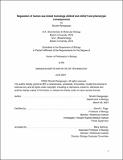Regulation of human sex-linked homologs DDX3X and DDX3Y and phenotypic consequences
Author(s)
Rengarajan, Shruthi
DownloadThesis PDF (2.145Mb)
Advisor
Page, David C.
Terms of use
Metadata
Show full item recordAbstract
The X-linked gene DDX3X and its Y-linked homolog DDX3Y comprise one of 17 gene pairs retained on the human X and Y chromosomes during their evolution from ordinary autosomes; both genes are widely expressed in human tissues. Mutations of DDX3X and DDX3Y result in a wide range of sex-dependent phenotypes, necessitating the study of their regulation.
In this thesis, we show that DDX3X is extraordinarily dosage-sensitive, and that perturbation of either DDX3X or DDX3Y expression is buffered -- by negative cross-regulation of DDX3X and DDX3Y in 46,XY cells, and by negative auto-regulation of DDX3X in 46,XX cells. In 46,XY cells, knockdown of either DDX3X or DDX3Y by CRISPRi causes transcript levels of the homologous gene to rise. In 46,XX cells, chemical inhibition of DDX3X protein activity elicits an increase in DDX3X transcript levels. This regulation is mediated through mRNA stability and buffers total levels of DDX3X and DDX3Y protein in human cells. Our findings indicate that gene regulatory mechanisms present on ancestral autosomes were retained and modified during the 200-million-year evolution of the human sex chromosomes.
This regulation has key consequences for human diseases. We re-analyzed data from the Cancer Dependency Map to identify genetic dependencies on the broadly expressed regulators on the Y chromosome. We find that DDX3Y is required for the survival of a set of cancer cell lines that present with loss-of-function mutations in DDX3X, uncovering a novel dependency in male tumors. Altogether, this work identifies a regulatory mechanism on the human sex chromosomes that has important consequences for human disease.
Date issued
2024-05Department
Massachusetts Institute of Technology. Department of BiologyPublisher
Massachusetts Institute of Technology